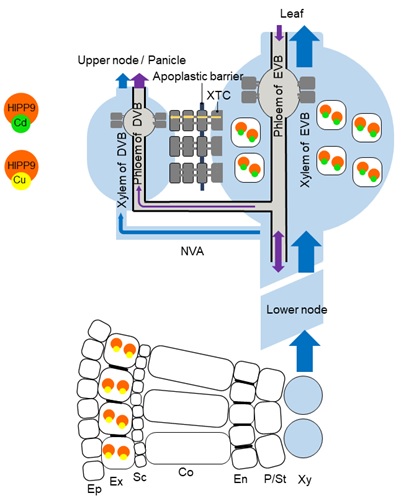Cadmium (Cd), a toxic heavy metal contaminant of cultivated land, harms human health due to its accumulation in crops, especially rice, which provides the majority of dietary Cd intake in Asian populations. Therefore, strategies to limit Cd accumulation in rice grain are urgently needed. In rice, Cd is absorbed from soil through root and then transported to tissues aboveground. Nodes, where vascular bundles linked with the roots, leaves and panicles, plays an important role in redirection of Cd in rice.
The research group led by Prof. QU Leqing from the Institute of Botany of the Chinese Academy of Sciences identified a Cd metallochaperone OsHIPP9 (heavy metal-associated isoprenylated plant protein 9) through Cd tolerance yeast screening system and characterized its function in rice via genetic, cellular and biochemical strategies. OsHIPP9 shows binding capacity for Cd and copper (Cu), mainly depends on the thiol in cysteines, to form a stable metal-protein complex. OsHIPP9 is primarily expressed in the xylem region of enlarged vascular bundles at nodes and root exodermis in rice. Knockout of OsHIPP9 increased the Cd concentrations of the upper nodes and panicle, but decreased Cd in expanded leaves, which possibly due to the changes in the distribution of Cd in the nodes. In addition, knockout of OsHIPP9 decreased Cu concentration in aboveground tissues in rice, wherease overexpression of OsHIPP9 increased Cu concentration in rice plants. These findings revealed the dual metallochaperone roles of OsHIPP9, chelating Cd in the xylem region of EVB for Cd retention in the nodes and chelating Cu in rice roots to aid Cu uptake, providing useful information for regulating the content of Cd and Cu in rice grain.
"OsHIPP9 may mediate more Cd migration into the leaves rather than the grain, which is crucial for reducing the content of Cd in grains", says the first author Dr. XIONG Shuo of the study.
The study entitled “Metallochaperone OsHIPP9 is involved in the retention of cadmium and copper in rice” has been published in Plant, Cell & Environment.

Schematic diagram showing the roles of OsHIPP9 in the retention of Cd and Cu in rice. (Image By IBCAS)
Article Link: https://doi.org/10.1111/pce.14576
Contact:
QU Leqing
Institute of Botany, the Chinese Academy of Sciences
Email: lqqu@ibcas.ac.cn
Cadmium (Cd), a toxic heavy metal contaminant of cultivated land, harms human health due to its accumulation in crops, especially rice, which provides the majority of dietary Cd intake in Asian populations. Therefore, strategies to limit Cd accumulation in rice grain are urgently needed. In rice, Cd is absorbed from soil through root and then transported to tissues aboveground. Nodes, where vascular bundles linked with the roots, leaves and panicles, plays an important role in redirection of Cd in rice.
The research group led by Prof. QU Leqing from the Institute of Botany of the Chinese Academy of Sciences identified a Cd metallochaperone OsHIPP9 (heavy metal-associated isoprenylated plant protein 9) through Cd tolerance yeast screening system and characterized its function in rice via genetic, cellular and biochemical strategies. OsHIPP9 shows binding capacity for Cd and copper (Cu), mainly depends on the thiol in cysteines, to form a stable metal-protein complex. OsHIPP9 is primarily expressed in the xylem region of enlarged vascular bundles at nodes and root exodermis in rice. Knockout of OsHIPP9 increased the Cd concentrations of the upper nodes and panicle, but decreased Cd in expanded leaves, which possibly due to the changes in the distribution of Cd in the nodes. In addition, knockout of OsHIPP9 decreased Cu concentration in aboveground tissues in rice, wherease overexpression of OsHIPP9 increased Cu concentration in rice plants. These findings revealed the dual metallochaperone roles of OsHIPP9, chelating Cd in the xylem region of EVB for Cd retention in the nodes and chelating Cu in rice roots to aid Cu uptake, providing useful information for regulating the content of Cd and Cu in rice grain.
"OsHIPP9 may mediate more Cd migration into the leaves rather than the grain, which is crucial for reducing the content of Cd in grains", says the first author Dr. XIONG Shuo of the study.
The study entitled “Metallochaperone OsHIPP9 is involved in the retention of cadmium and copper in rice” has been published in Plant, Cell & Environment.

Schematic diagram showing the roles of OsHIPP9 in the retention of Cd and Cu in rice. (Image By IBCAS)
Article Link: https://doi.org/10.1111/pce.14576
Contact:
QU Leqing
Institute of Botany, the Chinese Academy of Sciences
Email: lqqu@ibcas.ac.cn
